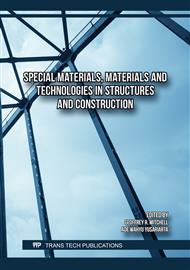[1]
[1]Di Bella Guido-CNR, I. T. A. E., "Joining of GFRPIN marine applications ". Advances in Materials Science Research, ISBN 978-1-62100-045-7, 12(6):185-215. 2012.
Google Scholar
[2]
D.K. Oh, Z.Q. Han, J.K. Noh, S.H. Jeong, "Laminate weight optimization of composite ship structures based on experimental data". J. Soc. Nav. Archit. Korea., 57(2):104-113. http://dx.doi.org/10.3744/SNAK.2020.57.2.104. 2020.
DOI: 10.3744/snak.2020.57.2.104
Google Scholar
[3]
J.Jang, Z. Han, D. Oh, "Light-weight Optimum Design of Laminate Structures of a GFRP Fishing Vessel". Journal of Ocean Engineering and Technology, 33(6):495-503. http://dx.doi.org/10.26748/KSOE.2019.105, 2019.
DOI: 10.26748/ksoe.2019.105
Google Scholar
[4]
P. Townsend, C. Astudillo, K. Larrea, J.C. Suarez, "Research on the Influence of Humidity on the Manufacture of GFRP Vessels in the Equatorial". Defect and Diffusion Forum, 432:69-74, https://doi.org/10.4028/p-22Wfse, 2024.
DOI: 10.4028/p-22wfse
Google Scholar
[5]
N. Calder, "Who Needs the Pressure and Composite Material Companies Continue to Develop Resins Designed for Outof-autoclave (OOA) Cures". Cytec reports. 2006.
Google Scholar
[6]
C. Anurag, C.K. Anvesh, S. Katam, "Auxetic materials". International Journal for Trends In Engineering & Technology, 5(2):156-160. - ISSN: 2349 – 9303, 2015.
Google Scholar
[7]
M. Balan, J. Mertens, M.R. Bahubalendruni, "Auxetic mechanical metamaterials and their futuristic developments: A state-of-art review". Materials Today Communications, 34(105285). https://doi.org/10.1016/j.mtcomm.2022.105285, 2023.
DOI: 10.1016/j.mtcomm.2022.105285
Google Scholar
[8]
A. Alderson, K. Alderson, "Proceedings of the Institution of Mechanical Engineers". Part G: Journal of Aerospace Engineering 221(4):565-575. https://doi.org/10.1243/09544100JAERO185, 2007.
DOI: 10.1243/09544100jaero185
Google Scholar
[9]
R. Johnston, Z. Kazancı, "Analysis of additively manufactured (3D printed) dual-material auxetic structures under compression" Additive Manufacturing, 38(101783). https://doi.org/10.1016/j.addma.2020.101783, 2021.
DOI: 10.1016/j.addma.2020.101783
Google Scholar
[10]
Z. Wang, H. Hu, "Auxetic materials and their potential applications in textiles. Textile Research Journal", 84(15):1600-1611. http://dx.doi.org/10.1177/0040517512449051, (2014)
DOI: 10.1177/0040517512449051
Google Scholar
[11]
L. Yanping, H. Hong, "A review on auxetic structures and polymeric materials". Scientific research and essays, 5(10):1052-1063. ISSN 1992-2248, 2010.
Google Scholar
[12]
Y. Prawoto, "Seeing auxetic materials from the mechanics point of view: A structural review on the negative Poisson's ratio." Computational Material Science. 58:140-153, https://doi.org/10.1016/j.commatsci.2012.02.012, 2012.
DOI: 10.1016/j.commatsci.2012.02.012
Google Scholar
[13]
O.E. Albag, "Auxetic materials. Material Balance: A Design Equation". SpringerBriefs in Applied Sciences and Technology, 65-74. https://doi.org/10.1007/978-3-030-54081-4, 2021.
DOI: 10.1007/978-3-030-54081-4_6
Google Scholar
[14]
ISO, "Plastics–determination of tensile properties". British Standard, Germany, 1997.
Google Scholar
[15]
P. Townsend, T. Frere, G. Jiménez, In process of publication, ICMMM2024. Approved in Key Engineering Materials.
Google Scholar
[16]
M. Barillas, "Materiales Auxeticos: una breve descripción y avances en la reducción de la concentración de esfuerzos". CONIA, 77-81 http://hdl.handle.net/11674/3812, 2019.
Google Scholar
[17]
C. Alía, J.M Arenas, J.C. Suárez, P. Pinilla. "Mechanical behavior of polyurethane adhesive joints used in laminated materials for marine structures". Ocean Engineering. 113:64-74, https://doi.org/10.1016/j.oceaneng.2015.12.044, 2016.
DOI: 10.1016/j.oceaneng.2015.12.044
Google Scholar
[18]
R. Magalhaes, P. Subramani, T..Lisner, "Development, characterization and analysis of auxetic structures from braided composites and study the influence of material and structural parameters". Composites Part A: Applied Science and Manufacturing, 87: 86-97 https://doi.org/10.1016/j.compositesa.2016.04.020, 2016.
DOI: 10.1016/j.compositesa.2016.04.020
Google Scholar
[19]
Kolken, H. M., & Zadpoor, A. A. (2017). Auxetic mechanical metamaterials. RSC advances, 7(9), 5111-5129.
DOI: 10.1039/c6ra27333e
Google Scholar


